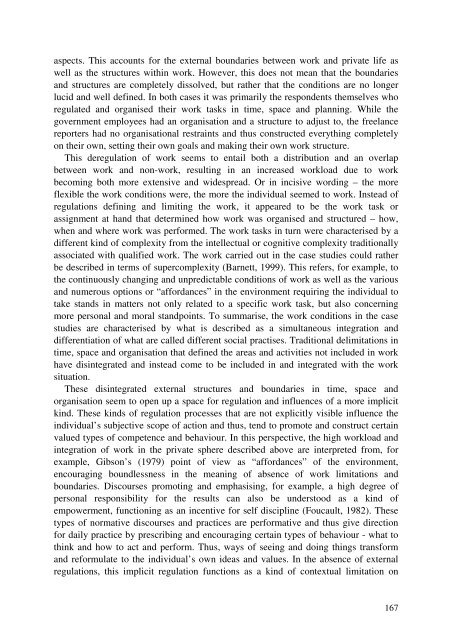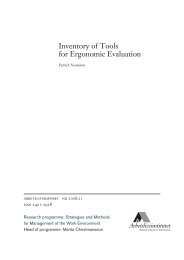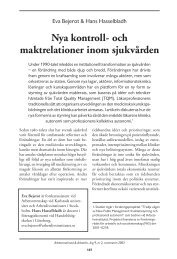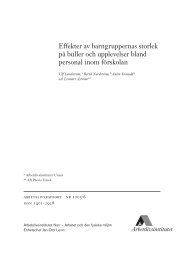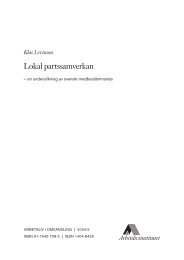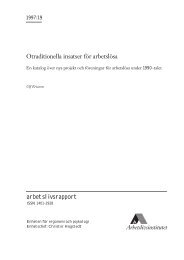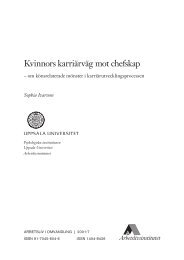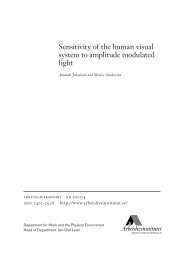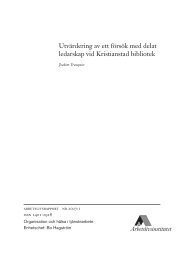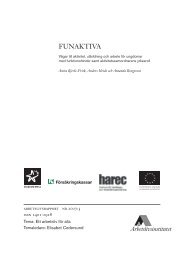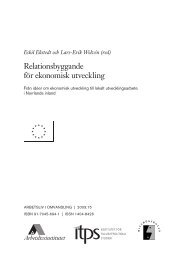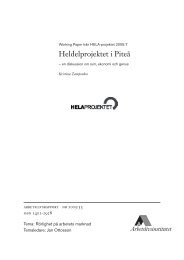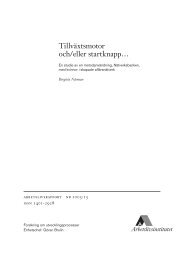Det flexibla arbetets villkor â om ... - Lunds universitet
Det flexibla arbetets villkor â om ... - Lunds universitet
Det flexibla arbetets villkor â om ... - Lunds universitet
- No tags were found...
You also want an ePaper? Increase the reach of your titles
YUMPU automatically turns print PDFs into web optimized ePapers that Google loves.
aspects. This accounts for the external boundaries between work and private life aswell as the structures within work. However, this does not mean that the boundariesand structures are c<strong>om</strong>pletely dissolved, but rather that the conditions are no longerlucid and well defined. In both cases it was primarily the respondents themselves whoregulated and organised their work tasks in time, space and planning. While thegovernment employees had an organisation and a structure to adjust to, the freelancereporters had no organisational restraints and thus constructed everything c<strong>om</strong>pletelyon their own, setting their own goals and making their own work structure.This deregulation of work seems to entail both a distribution and an overlapbetween work and non-work, resulting in an increased workload due to workbec<strong>om</strong>ing both more extensive and widespread. Or in incisive wording – the moreflexible the work conditions were, the more the individual seemed to work. Instead ofregulations defining and limiting the work, it appeared to be the work task orassignment at hand that determined how work was organised and structured – how,when and where work was performed. The work tasks in turn were characterised by adifferent kind of c<strong>om</strong>plexity fr<strong>om</strong> the intellectual or cognitive c<strong>om</strong>plexity traditionallyassociated with qualified work. The work carried out in the case studies could ratherbe described in terms of superc<strong>om</strong>plexity (Barnett, 1999). This refers, for example, tothe continuously changing and unpredictable conditions of work as well as the variousand numerous options or “affordances” in the environment requiring the individual totake stands in matters not only related to a specific work task, but also concerningmore personal and moral standpoints. To summarise, the work conditions in the casestudies are characterised by what is described as a simultaneous integration anddifferentiation of what are called different social practises. Traditional delimitations intime, space and organisation that defined the areas and activities not included in workhave disintegrated and instead c<strong>om</strong>e to be included in and integrated with the worksituation.These disintegrated external structures and boundaries in time, space andorganisation seem to open up a space for regulation and influences of a more implicitkind. These kinds of regulation processes that are not explicitly visible influence theindividual’s subjective scope of action and thus, tend to pr<strong>om</strong>ote and construct certainvalued types of c<strong>om</strong>petence and behaviour. In this perspective, the high workload andintegration of work in the private sphere described above are interpreted fr<strong>om</strong>, forexample, Gibson’s (1979) point of view as “affordances” of the environment,encouraging boundlessness in the meaning of absence of work limitations andboundaries. Discourses pr<strong>om</strong>oting and emphasising, for example, a high degree ofpersonal responsibility for the results can also be understood as a kind ofempowerment, functioning as an incentive for self discipline (Foucault, 1982). Thesetypes of normative discourses and practices are performative and thus give directionfor daily practice by prescribing and encouraging certain types of behaviour - what tothink and how to act and perform. Thus, ways of seeing and doing things transformand reformulate to the individual’s own ideas and values. In the absence of externalregulations, this implicit regulation functions as a kind of contextual limitation on167


